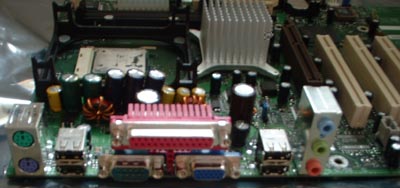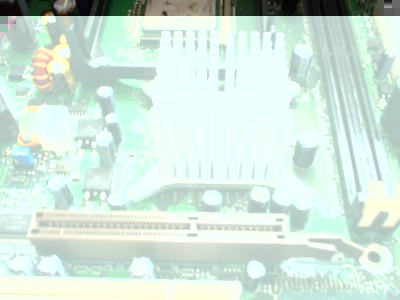 |
|
|
|
In the Forums... |
Posted: May 20th, 2002 Written by: Tuan Huynh Sound Max w/SPX I wonít go much into Sound Max this time around, as Iíve covered it in my Intel Desktop Board article. While the boards used in the original Intel Desktop Boards article featured an Analog Devices AD1885 ACí97 16-bit codec, the i845G board we received featured an updated AD1981A 20-Bit audio codec. Just to cut things short, I played a few MP3ís using Sound Max with Windows Media Player, and the audio quality was excellent. The sound quality of the new codec was excellent and sounded very nice coming out of my Logitech Z560ís. The music sounded clear, the bass had warmth, and the overall sound is able to rival the Sound Blaster Live Audigy. Being an onboard codec solution, the quality of the sound is astonishing; it makes you wonder why Analog Devices doesnít want to get into the DSP business. Gaming CPU Utilization  For testing the amount of CPU power Sound Max uses, I used Quake 3 Arena Demo Four with the settings set to normal at 640x480, because at 640x480, the game is CPU dependant and any major use of the processor will show as a decrease in FPS. When it comes to playing games, Sound Max is able to serve very well. Comparing the difference with sound enabled and with sound disabled, the performance is nearly identical. This shows that ADI has really been tweaking their drivers for performance. Overall Sound Max is still an awesome audio solution, with the new AD1981A 20-bit audio codec; the sound quality has just been improved a little bit and allows Sound Max to compete with the Audigy in terms of audio quality. The Board  The i845G board we received is a production board thatíll most likely find its way into systems from Dell, Gateway, and occasional store shelves. Like every other Intel board, the D845GBV shares a very similar layout as the D845BG. Since Intel isnít really trying to market the D845GBV as an enthusiastís board, the board is pretty basic in layout with just the typical dull green PCB.  On the connector side of things, the D845GBV uses the traditional Intel port layout. From left to right you get your PS2 keyboard/mouse ports, 2 USB 2.0 ports, Serial port, VGA connector, Parallel port, another 2 USB 2.0 ports, and the onboard Sound Max audio connectors.  Unlike the majority of the boards available on the market, the D845GBV features a total of 6 PCI slots for your expanding pleasure, as well as a CNR slot for adding a CNR Ethernet card or expanding Sound Max to 5.1. Next to the top two PCI slots youíll see the huge Intel ICH4 which provides support for up to 6 USB 2.0 ports. Right next to the 4th PCI slot lays the extra USB headers just in case you want to add the extra 2 USB 2.0 ports. Unlike the other Intel boards, the D845GBV doesnít seem to have an extra header for a second serial port which can usually be found on the Intel boards. It appears Intel is moving slowly towards legacy free.  As with most i845 based boards, the D845GBV only has 2 DIMM slots which support up to 2GB of PC2100 DDR memory. Right below the DIMM slots are the IDE connectors, and the ATX power connector which is conveniently placed to avoid getting into the way of the processor heatsink.  Atop the i845G lays a rather large passive heatsink which is soldered directly onto the board. Since I have bad soldering skills, I didnít try to take off the heatsink to expose the north bridge. Unlike the past few Intel boards that just had a plastic retention clip attached on the AGP4x connector, the D845GBV features an updated AGP slot which has the retention clip permanently attached. |
||
|
| |||
|---|---|---|---|